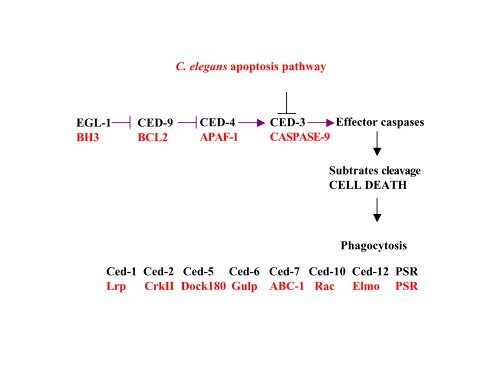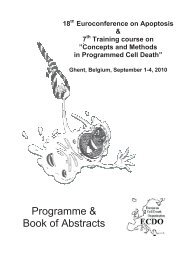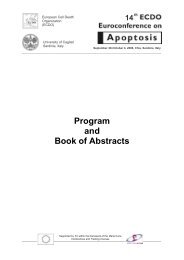C. elegans apoptosis pathway EGL-1 BH3 CED-9 BCL2 ... - DMBR
C. elegans apoptosis pathway EGL-1 BH3 CED-9 BCL2 ... - DMBR
C. elegans apoptosis pathway EGL-1 BH3 CED-9 BCL2 ... - DMBR
You also want an ePaper? Increase the reach of your titles
YUMPU automatically turns print PDFs into web optimized ePapers that Google loves.
<strong>EGL</strong>-1<br />
<strong>BH3</strong><br />
<strong>CED</strong>-9<br />
<strong>BCL2</strong><br />
C. <strong>elegans</strong> <strong>apoptosis</strong> <strong>pathway</strong><br />
<strong>CED</strong>-4<br />
APAF-1<br />
<strong>CED</strong>-3<br />
CASPASE-9<br />
Effector caspases<br />
Subtrates cleavage<br />
CELL DEATH<br />
Phagocytosis<br />
Ced-1 Ced-2 Ced-5 Ced-6 Ced-7 Ced-10 Ced-12 PSR<br />
Lrp CrkII Dock180 Gulp ABC-1 Rac Elmo PSR
Phagocytosis of apoptotic cells in C. <strong>elegans</strong><br />
<strong>CED</strong>-1<br />
<strong>CED</strong>-7<br />
(ABC-1)<br />
<strong>CED</strong>-7<br />
(ABC-1)<br />
(SR-EC/LRP)<br />
<strong>CED</strong>-6<br />
(GULP)<br />
Apoptotic corpse<br />
PSR1<br />
<strong>CED</strong>-2<br />
(CrkII)<br />
Neighboring cell<br />
<strong>CED</strong>-5<br />
(Dock180)<br />
Apoptotic ligands ???<br />
<strong>CED</strong>-12<br />
(Elmo)<br />
<strong>CED</strong>-10<br />
GTP (Rac)
Model systems for studying Development<br />
-Plants ( A. thaliana)<br />
-Worms (C. <strong>elegans</strong>)<br />
-Fruit flies ( D.melanogaster )<br />
- Zebrafish (D. rerio )
3.5-4.5 days<br />
Drosophila as a Model System<br />
1. Short generation time ~10 days<br />
Pupae<br />
Adults<br />
pupariation<br />
2.5-3 days<br />
mating<br />
fertilization<br />
First<br />
Second<br />
Third Instar Larvae<br />
Embryo<br />
embryogenesis<br />
1 day<br />
3x1 day
Drosophila as a Model System<br />
2. Complex body plan
Drosophila as a Model System<br />
3. Only 4 chromosomes<br />
_The first physical and genetic map<br />
Centimorgan : 1% recombination<br />
(Sturtevant and Morgan)<br />
TH Morgan Nobel lecture 1933<br />
_Polytene chromosomes<br />
In situ hybridization<br />
_Positional cloning, cDNA and<br />
chromosomal libraries ( Hogness )<br />
_Genome project completed
Drosophila as a Model System<br />
4. Genetic approach :<br />
• Loss of function genetics:<br />
Chemically generated mutants (EMS, ENU)<br />
Chromosomal deficiencies (~ 85% of the genome, X-rays, γ-rays, P-elements)<br />
Transposable elements<br />
Gene knockout by homologous recombination<br />
Mosaic analysis: making clones of mutant cells in a normal tissue (FLP/FRT)<br />
• Gain of function genetics:<br />
Dominant mutants<br />
Chromosome duplications<br />
Tissue specific expression systems: UAS/Gal-4<br />
• Biochemical<br />
HPLC purification from whole organism extracts
Drosophila as a Model System<br />
5. Molecular approach :<br />
•A physical map that corresponds to the genetic map: Fully sequenced, genetically<br />
marked genome.<br />
•Excellent cytogenetics : Genome is arrayed on overlapping Bacterial Artificial<br />
Chromosome (BAC) clones, SNPs mapping,<br />
•ESTs (Expressed Sequence Tags) characterized for all stages of the life cycle,<br />
•Genome-wide microarrays ,<br />
•Antibodies and transposable elements to mark gene products, cell morphology and<br />
subcellular structure,<br />
•Stable single copy transformation,<br />
•Targeted, tissue specific expression systems (UAS/Gal-4),<br />
•Genome-wide RNAi library allow double stranded RNA bathing/ transfection of cultured<br />
cells to address partial or complete LOF phenotypes,<br />
•First genome-wide two hybrid screen (protein-protein interaction)<br />
•And the fly community will not stop there!
Normal Cell<br />
Cell shrinkage away<br />
from neighbouring cells<br />
Plasma membrane blebbing<br />
Cytoplasmic and nuclear condensation<br />
Nuclear and cellular<br />
fragmentation<br />
Apoptotic Bodies<br />
Margination of condensed<br />
chromatin<br />
Phagocytosis
The importance of PCD in development and homeostasis<br />
are needed to see this picture.<br />
Baehrecke Nat Rev Mol Cell Biol. 2002 Oct;3(10):779-87 .
Consequences of deregulation of PCD<br />
Excessive cell death :<br />
Degenerative neurological disorders<br />
Stroke, cardiac ischemia,<br />
Immune suppression associated with AIDS<br />
Suppression of cell death:<br />
Autoimmune diseases<br />
Cancer
Programmed Cell Death (PCD)<br />
1. Cell Death Signal<br />
2. Execution of Death<br />
3. Engulfment of remains<br />
htp:/www.cel death-<strong>apoptosis</strong>.org/ apop _pic .htm<br />
Galen Fumiyo Kubo<br />
Galen<br />
Picture by M Janes & P Henson Nature. 2000 Oct 12;407(6805):784-8
Programmed cell death during Drosophila embryogenesis<br />
John M. Abrams1, Kristin White1, Liselotte I. Fessler2 and Hermann Steller1<br />
Development 117, 29-43 (1993)<br />
1Howard Hughes Medical Institute, Department of Brain and Cognitive Sciences and Department of<br />
Biology, Massachusetts. Institute of Technology, Cambridge, Massachusetts 02139, USA<br />
2Molecular Biology Institute and Biology Department, University of California, Los Angeles, CA 90024,<br />
USA<br />
Acridine orange staining<br />
Allowed for the initiation of a deficiency screen for PCD mutants
A deficiency kit that covers over 85% of the genome!!!<br />
_allows for the rapid screening of the entire genome<br />
for genes involved in any embryonic phenotype of interest<br />
Genetic definition of a<br />
deficiency:<br />
contains at least two<br />
complementation<br />
groups,<br />
Overlapping<br />
deficiencies provide still<br />
finer resolution,<br />
Isogenic deletions with<br />
precise breakpoints<br />
(drosdel project)
Homozygous Df(3L)H99 embryos lack all PCD<br />
WT<br />
H99<br />
Acridine orange
HID<br />
The H99 deletion allowed for the identification of<br />
three regulators of PCD, rpr, hid, and grim<br />
GRIM<br />
RPR
No homology of sequences except in their first 14 aa: RHG/IBM motif<br />
Rpr 65 aa<br />
Trp block<br />
Grim<br />
Hid<br />
Smac<br />
138 aa<br />
239 aa<br />
Reaper 2 AVAFYIPDQATLL 14<br />
Grim 2 AIAYFIPDQAQLL 14<br />
Hid 2 AVPFYLPEGGADD 14<br />
Sickle 2 AIPFYEEEHAPKS 14<br />
Jafrac2 - AKPE -<br />
Smac /Diablo 54 AVPI 66<br />
Sickle 108 aa<br />
AKP<br />
410 aa<br />
Jafrac 2 ERS peroxidase domain 242 aa
Early embryogenesis in Drosophila<br />
Nuclei cleave in a common cytoplasm ( syncytium)<br />
At cycle 10, nuclei migrate to the periphery ( blastoderm )
Germ line transgenic making in the fly<br />
Used in:<br />
_Rescue experiments (replacement strategy)<br />
_Over-expression experiments<br />
_Homologous recombination
Genetic screens for enhancers and suppressors of PCD in the eye<br />
QuickTime and a<br />
Graphics decompressor<br />
are needed to see this picture.
Inhibitors/suppressors of <strong>apoptosis</strong><br />
dIAP1 blocks both reaper and hid-induced cell death<br />
dBRUCE blocks reaper-induced cell death but not hid<br />
dIAP2 not a very good inhibitor of PCD, cell migration role<br />
DETERIN is most homologous to survivin as it has a single BIR<br />
dIAP 1/thread<br />
dIAP 2<br />
BIR1 BIR2<br />
RING<br />
438 aa<br />
dBRUCE BIR<br />
UBC<br />
DETERIN<br />
BIR1 BIR2 BIR3 RING 498 aa<br />
BIR 153 aa<br />
4876 aa
DIAP-1: a central player<br />
thread LOF mutation shows increased PCD in the embryo,<br />
and is embryonic lethal.<br />
thread is epistatic to rpr, hid and grim.<br />
GOF of Diap1prevents rpr, hid and grim-induced death.<br />
GMR transgene alone has no effect, but it can inhibit<br />
Dronc and Debcl -induced death, thus it genetically<br />
interacts with Dronc, a caspase gene , and Debcl , a Death<br />
enhancer with Bcl-2 homology (pro-apoptotic Bcl-2<br />
homologue).
There are 7 Drosophila CASPASES<br />
Cysteine/ASPartate proteASES related to Ced-3<br />
Apical DRONC<br />
DECAY<br />
DRICE<br />
Apical DREDD/DCP2<br />
DAMM<br />
DCP-1<br />
STRICA/DREAM<br />
DED DED<br />
CARD p20<br />
Ser/Thr Rich<br />
p20<br />
p14<br />
large small<br />
p12<br />
p20 p10<br />
p20 small<br />
p20 p13<br />
p20 small<br />
CARD: Caspase Activation Recruitment Domain and<br />
DED: Death Effector Domain are protein-protein interactions domains
Caspases phenotypes and interactions<br />
Dronc RNAi prevents PCD in the embryo, Dronc deficiency and<br />
Dronc dominant negative transgene genetically interact with rpr,<br />
hid and grim; Dronc over-expression induces cell death.<br />
Dredd LOF have a defect in the immune response.<br />
Damm dominant negative transgene genetically interacts with<br />
hid, and over- expression of Damm induces death.<br />
DCP-1 LOF is lethal at third instar larval stage with no imaginal<br />
discs or gonads and melanotic tumors.<br />
Drice , Decay, Strica : no LOF mutation. Drice over- expression has<br />
no effect.<br />
Drice and Dcp-1 bind to BIR1 of DIAP-1, and act downstream of<br />
Dronc
Gas Brake<br />
RPR<br />
HID<br />
GRIM<br />
SICKLE ?<br />
JAFRAC2 ?<br />
The Drosophila Gas and Brake model<br />
DIAP-1 DRONC<br />
BIR-2<br />
Death initiators and effectors<br />
CELL<br />
DEATH<br />
_RPR, HID and GRIM (gas) compete with DRONC for<br />
binding to BIR2 domain of DIAP1 (brake), which<br />
inhibits DRONC.<br />
_Upon cell death signals, RPR, HID or GRIM (gas) bind<br />
to DIAP-1 (BIR-2), competing for it with DRONC. Thus<br />
the brake (DIAP1) is released from DRONC, the caspase<br />
is activated and cell death occurs.
CARD<br />
APAF-1<br />
CARD<br />
DARK<br />
BUFFY<br />
DEBCL/<br />
DROB-1/<br />
DBORG-1<br />
NBD<br />
Apaf -1 related DARK<br />
WD40 repeats<br />
NBD WD40 repeats<br />
Cytochrome c interaction ?<br />
IAP antagonists of the Bcl-2 family: Buffy and Debcl<br />
a1 a2<br />
<strong>BH3</strong> BH1 BH2<br />
<strong>BH3</strong> BH1 BH2<br />
Membrane anchor<br />
300 aa<br />
Membrane anchor
Closed<br />
monomer<br />
The apoptosome in mammals<br />
Cyt C<br />
procaspase ?<br />
Inactive<br />
monomer<br />
WD40<br />
Open<br />
Heptamer<br />
Inactive<br />
active<br />
Active<br />
dimer
A<br />
C<br />
Drosophila apoptosome: how does it function ?<br />
Cytochrome c release involvement still a question ?<br />
Pro-apoptotic Debcl<br />
B<br />
Anti-apoptotic Buffy<br />
displaced by Debcl ?
RNAi Mechanism<br />
Introduction of<br />
TRIGGER dsRNA<br />
DICER: processes<br />
21-23nt siRNA<br />
RISC: destruction of<br />
TARGET mRNA<br />
RNA interference in Drosophila S2 cells<br />
approx. 500nt<br />
dsRNA<br />
mRNA<br />
Loss-of-function phenotype<br />
438 essential genes !<br />
RNAi<br />
In S2 cells<br />
• dsRNA to serum-free medium<br />
(Clemens, et al. 2000 PNAS 97: 6499)<br />
• Partial to complete<br />
loss of function<br />
• Uniform penetrance
mir-2,<br />
mir-13 family ?<br />
MicroRNAs in Drosophila <strong>apoptosis</strong><br />
Developmental and environmental death signals<br />
?<br />
Bantam<br />
GRIM<br />
REAPER<br />
SICKLE<br />
HID<br />
DIAP1<br />
Cell Growth and proliferation<br />
DARK<br />
DRONC<br />
DRICE<br />
mir-14<br />
CELL DEATH FAT LEVELS<br />
Transcriptional control: RNAi/transcription complex, chromatin silencing
Intrinsic death signals<br />
Drosophila intrinsic and extrinsic PCD <strong>pathway</strong>s<br />
Extrinsic death signals Innate immune<br />
?<br />
response<br />
Death receptor<br />
TNFR family<br />
Diap-1<br />
?<br />
dFADD Dredd<br />
?<br />
UV Sickle<br />
Rpr, Grim. Hid<br />
?<br />
?<br />
Dmp53<br />
Debcl<br />
Dark Initiator<br />
Caspases<br />
Cytochrome c<br />
?<br />
Dronc<br />
Dredd<br />
<strong>BH3</strong> only<br />
?<br />
Buffy<br />
?<br />
Effector<br />
Caspases<br />
Dcp-1<br />
Drice<br />
CELL<br />
DEATH<br />
Phagocytosis
Programmed Cell Death (PCD)<br />
1. Cell Death Signal<br />
2. Execution of Death<br />
3. Engulfment of remains<br />
htp:/www.cel death-<strong>apoptosis</strong>.org/ apop _pic .htm<br />
Galen Fumiyo Kubo<br />
Galen<br />
Picture by M Janes & P Henson Nature. 2000 Oct 12;407(6805):784-8
<strong>EGL</strong>-1<br />
<strong>BH3</strong><br />
<strong>CED</strong>-9<br />
<strong>BCL2</strong><br />
C. <strong>elegans</strong> <strong>apoptosis</strong> <strong>pathway</strong><br />
<strong>CED</strong>-4<br />
APAF-1<br />
<strong>CED</strong>-3<br />
CASPASE-9<br />
Effector caspases<br />
Subtrates cleavage<br />
CELL DEATH<br />
Phagocytosis<br />
Ced-1 Ced-2 Ced-5 Ced-6 Ced-7 Ced-10 Ced-12 PSR<br />
Lrp CrkII Dock180 hCed-6 ABC-1 Rac Elmo PSR?
A role for Draper in phagocytosis of apoptotic cells<br />
by l(2) mbn and SL2 cells and embryonic macrophages<br />
DRAPER, a <strong>CED</strong>-1 homologue is expressed at the<br />
membrane of glial cells and of embryonic macrophages<br />
Draper RNAi in l(2)mbn and SL2 cells prevents engulfment<br />
of apoptotic cells<br />
Crq RNAi does not prevent engulfment of apoptotic cells<br />
Although the mRNA is targeted, the endogenous protein is<br />
still present<br />
Draper RNAi by injection of dsRNA in embryos reduces the<br />
engulfment of apoptotic cells in vivo .<br />
Nakanishi and colleagues, 2004.
AND THERE IS SO MUCH MORE TO LEARN!<br />
EGFR/Ras<br />
Eiger /TNF<br />
MAPK/Junk <strong>pathway</strong><br />
Hippo/salvador/warts regulators of cell growth<br />
PCD and cell competition<br />
DIAP2 in innate immunity<br />
DIAP2 in cell migration<br />
AUTOPHAGY<br />
Etc…<br />
John Abrams<br />
Julie Agapite<br />
Nicholas Baker<br />
Eric Baehrecke<br />
Andreas Bergmann<br />
Steve Cohen<br />
Megan Grether<br />
Ernst Hafen<br />
Ishwar Hariharan<br />
Bruce Hay<br />
Sally Kornbluth<br />
Sharad Kumar<br />
Kim McCall<br />
Pascal Meier<br />
John Nambu<br />
Yoshinobu Nakanishi<br />
Gerry Rubin<br />
Hermann Steller<br />
Nicolas Tapon<br />
Craig Thompson<br />
Kristin White…<br />
and colleagues!!!!!!!













